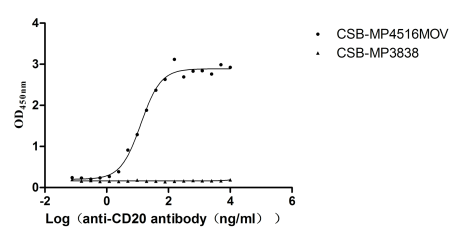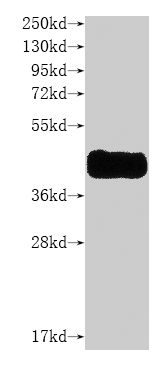Recombinant Human Cohesin subunit SA-2 (STAG2), partial
-
中文名稱:人STAG2重組蛋白
-
貨號(hào):CSB-YP839791HU
-
規(guī)格:
-
來源:Yeast
-
其他:
-
中文名稱:人STAG2重組蛋白
-
貨號(hào):CSB-EP839791HU
-
規(guī)格:
-
來源:E.coli
-
其他:
-
中文名稱:人STAG2重組蛋白
-
貨號(hào):CSB-EP839791HU-B
-
規(guī)格:
-
來源:E.coli
-
共軛:Avi-tag Biotinylated
E. coli biotin ligase (BirA) is highly specific in covalently attaching biotin to the 15 amino acid AviTag peptide. This recombinant protein was biotinylated in vivo by AviTag-BirA technology, which method is BriA catalyzes amide linkage between the biotin and the specific lysine of the AviTag.
-
其他:
-
中文名稱:人STAG2重組蛋白
-
貨號(hào):CSB-BP839791HU
-
規(guī)格:
-
來源:Baculovirus
-
其他:
-
中文名稱:人STAG2重組蛋白
-
貨號(hào):CSB-MP839791HU
-
規(guī)格:
-
來源:Mammalian cell
-
其他:
產(chǎn)品詳情
-
純度:>85% (SDS-PAGE)
-
基因名:
-
Uniprot No.:
-
別名:bA517O1.1; Cohesin Subunit SA 2; Cohesin subunit SA-2; DKFZp686P168; DKFZp781H1753; FLJ25871; SA 2; SA-2; SA2; SCC3 homolog 2; SCC3B; STAG 2; stag2; STAG2_HUMAN; Stromal antigen 2
-
種屬:Homo sapiens (Human)
-
蛋白長度:Partial
-
蛋白標(biāo)簽:Tag?type?will?be?determined?during?the?manufacturing?process.
The tag type will be determined during production process. If you have specified tag type, please tell us and we will develop the specified tag preferentially. -
產(chǎn)品提供形式:Lyophilized powder
Note: We will preferentially ship the format that we have in stock, however, if you have any special requirement for the format, please remark your requirement when placing the order, we will prepare according to your demand. -
復(fù)溶:We recommend that this vial be briefly centrifuged prior to opening to bring the contents to the bottom. Please reconstitute protein in deionized sterile water to a concentration of 0.1-1.0 mg/mL.We recommend to add 5-50% of glycerol (final concentration) and aliquot for long-term storage at -20℃/-80℃. Our default final concentration of glycerol is 50%. Customers could use it as reference.
-
儲(chǔ)存條件:Store at -20°C/-80°C upon receipt, aliquoting is necessary for mutiple use. Avoid repeated freeze-thaw cycles.
-
保質(zhì)期:The shelf life is related to many factors, storage state, buffer ingredients, storage temperature and the stability of the protein itself.
Generally, the shelf life of liquid form is 6 months at -20°C/-80°C. The shelf life of lyophilized form is 12 months at -20°C/-80°C. -
貨期:Delivery time may differ from different purchasing way or location, please kindly consult your local distributors for specific delivery time.Note: All of our proteins are default shipped with normal blue ice packs, if you request to ship with dry ice, please communicate with us in advance and extra fees will be charged.
-
注意事項(xiàng):Repeated freezing and thawing is not recommended. Store working aliquots at 4°C for up to one week.
-
Datasheet :Please contact us to get it.
相關(guān)產(chǎn)品
靶點(diǎn)詳情
-
功能:Component of cohesin complex, a complex required for the cohesion of sister chromatids after DNA replication. The cohesin complex apparently forms a large proteinaceous ring within which sister chromatids can be trapped. At anaphase, the complex is cleaved and dissociates from chromatin, allowing sister chromatids to segregate. The cohesin complex may also play a role in spindle pole assembly during mitosis.
-
基因功能參考文獻(xiàn):
- STAG2 deficiency induces interferon responses via cGAS-STING pathway and restricts virus infection. PMID: 29662124
- STAG2 loss of Expression is Associated with Cancer Progression in Upper Urinary Tract Carcinoma. PMID: 28967037
- these data suggest that STAG2 acts as a tumor suppressor gene in bladder cancer and may be a potential therapeutic target in bladder cancer PMID: 28627627
- Extending the lifespan of normal human cells due to inactivation of STAG2 could promote tumorigenesis by extending the period during which tumor-driving mutations occur. PMID: 28819029
- TAG2 is the most commonly mutated subunit, and in a recent analysis was identified as one of only 12 genes that are significantly mutated in four or more cancer types. PMID: 27207471
- the clinical features of these three cases are remarkably similar to those observed in other well-established cohesinopathies. Herein, we suggest that STAG2 is a dosage-sensitive gene and that heterozygous loss-of-function variants lead to a cohesinopathy. PMID: 28296084
- results indicated that the complete loss of STAG2 expression was predictive for better recurrence-free survival and cancer-specific survival, suggesting its potential value as a prognostic biomarker in bladder cancer PMID: 26838030
- We suggest that increased STAG2 gene copy number and dysregulation of its downstream target genes may be responsible for the specific clinical findings of this syndrome. PMID: 25677961
- Characterization of C-terminal nuclear localization signal of the human SA2 stromalin PMID: 25979289
- Data show a significantly higher stromal antigen 2 (STAG2) mRNA and protein levels in normal bladder cells than bladder cancer cells. PMID: 25867412
- Microduplication of chromosome Xq25 encompassing STAG2 gene in a boy with intellectual disability PMID: 25450604
- STAG2 promotes the correction of kMT attachment errors to ensure faithful chromosome segregation during mitosis. PMID: 25074805
- Genomic landscape of Ewing sarcoma defines an aggressive subtype with co-association of STAG2 and TP53 mutations PMID: 25223734
- Loss of STAG2 expression occurs in 15% of tumors and is associated with metastatic disease, suggesting a potential genetic vulnerability in Ewing sarcoma PMID: 25186949
- our study identifies the duplication of XIAP and STAG2 as the minimal duplicated region leading to the ID, facial morphological anomalies, and speech delay, specific to the patients with Xq25 duplication. PMID: 24733578
- In an independent EFT tissue microarray cohort, we show that STAG2 loss as detected by immunohistochemistry may be associated with more advanced disease (p = 0.15) and a modest decrease in overall survival (p = 0.10). PMID: 25010205
- Aneuploidy in human salivary gland carcinomas is not driven by loss of expression of STAG2. PMID: 24822266
- These data suggest that PARP is a potential target for tumors harboring inactivating mutations in STAG2, and strongly recommend that STAG2 status be determined and correlated with therapeutic response to PARP inhibitors PMID: 24356817
- Cross-sectional deep-sequencing analysis for clonal hierarchy demonstrated STAG2, SMC3, and RAD21 mutations to be ancestral in 18%, 18%, and 47% of cases, respectively, and each expanded to clonal dominance concordant with disease transformation PMID: 25006131
- Loss of STAG2 function is associated with non-invasive bladder cancer. PMID: 24270882
- Mutations in STAG2 is associated with acute myeloid leukemia. PMID: 24335498
- STAG2 is one of the most commonly mutated genes in bladder cancer. PMID: 24121789
- STAG2 is a new urothelial bladder cancer tumor suppressor acting through mechanisms that are different from its role in preventing aneuploidy. PMID: 24121791
- Inactivating point mutations in the STAG2 gene are not common in neuroblastoma tumors PMID: 24088605
- Somatic mutation of STAG2, an aneuploidy-related gene, is rare in acute leukemias. PMID: 22132872
- Low STAG2 expression and not mutation is associated with neoplasms. PMID: 22668012
- study has shown that diverse human cancers harbor mutations in the X-linked chromatid cohesion gene STAG2 and that these mutations cause aneuploidy PMID: 21852505
- evidence suggests STAG2 functions as a transcriptional co-activator by a mechanism involving protein-protein interactions with transcription factors PMID: 14660624
- Phosphorylation of SA2 is essential for cohesin dissociation during prophase and prometaphase, but is not required for cohesin cleavage by separase. PMID: 15737063
- Cohesion between sister chromatids is essential for their bi-orientation on mitotic spindles is mediated by a multisubunit complex called cohesin. PMID: 15737064
顯示更多
收起更多
-
亞細(xì)胞定位:Nucleus. Chromosome. Chromosome, centromere. Note=Associates with chromatin. Before prophase it is scattered along chromosome arms. During prophase, most of cohesin complexes dissociate from chromatin probably because of phosphorylation by PLK1, except at centromeres, where cohesin complexes remain. At anaphase, the RAD21 subunit of cohesin is cleaved, leading to the dissociation of the complex from chromosomes, allowing chromosome separation. In germ cells, cohesin complex dissociates from chromatin at prophase I, and may be replaced by a meiosis-specific cohesin complex.
-
蛋白家族:SCC3 family
-
數(shù)據(jù)庫鏈接:
Most popular with customers
-
Recombinant Human Ephrin type-A receptor 3 (EPHA3), partial (Active)
Express system: Mammalian cell
Species: Homo sapiens (Human)
-
Recombinant Human Membrane cofactor protein (CD46), partial (Active)
Express system: Mammalian cell
Species: Homo sapiens (Human)
-
Express system: Mammalian cell
Species: Homo sapiens (Human)
-
Recombinant Human Tyrosine-protein kinase Mer (MERTK), partial (Active)
Express system: Mammalian cell
Species: Homo sapiens (Human)
-
Recombinant Human Claudin-6 (CLDN6)-VLPs, Fluorescent (Active)
Express system: Mammalian cell
Species: Homo sapiens (Human)
-
Recombinant Macaca fascicularis Membrane spanning 4-domains A1 (MS4A1)-VLPs (Active)
Express system: Mammalian cell
Species: Macaca fascicularis (Crab-eating macaque) (Cynomolgus monkey)
-
Recombinant Human C-C chemokine receptor type 8 (CCR8)-VLPs (Active)
Express system: Mammalian cell
Species: Homo sapiens (Human)
-
Recombinant Macaca fascicularis Gastric inhibitory polypeptide receptor (GIPR), partial (Active)
Express system: yeast
Species: Macaca fascicularis (Crab-eating macaque) (Cynomolgus monkey)


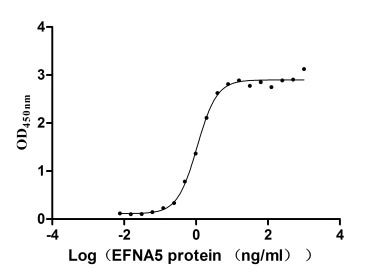
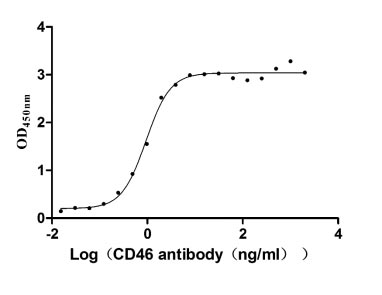
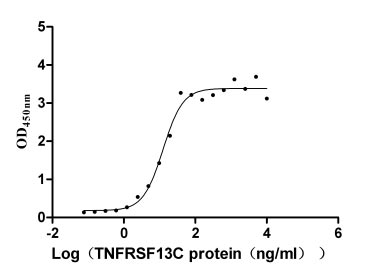
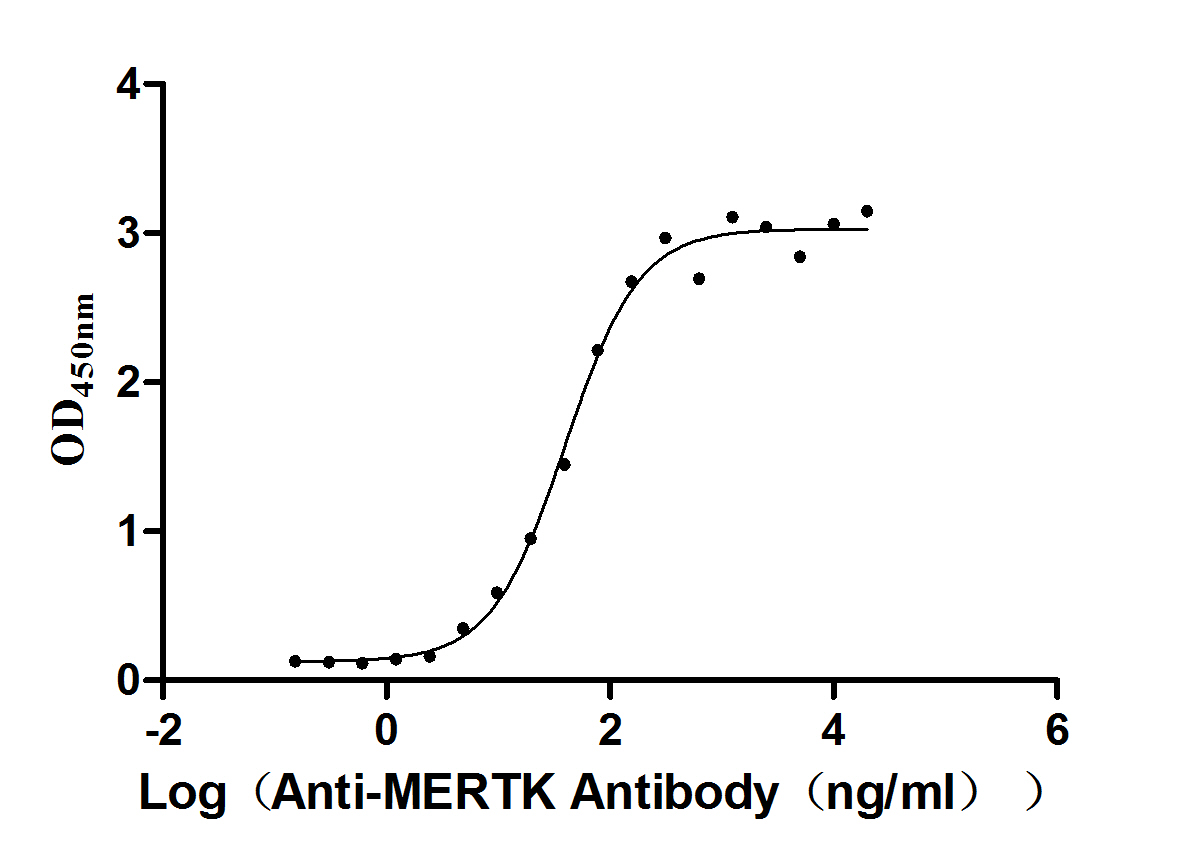
f4-AC1.jpg)
